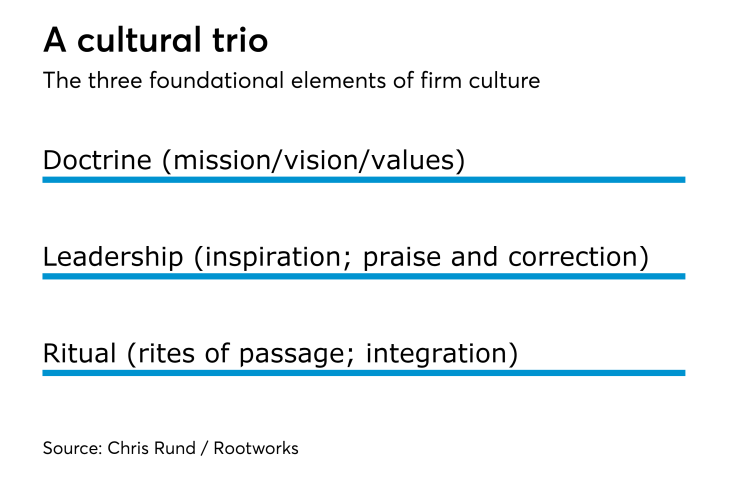Building a firm culture is about much more than installing a ping-pong table in your breakroom, industry expert Chris Rund told a recent gathering of accounting firm leaders.
“Culture is one of those slippery things – it’s not numbers, it’s all that touchy-feely stuff,” Rund, a marketing and brand development strategist and creative director at accounting firm advisors Rootworks, told attendees at a Rootworks Partner Retreat in late June. “Culture is ‘the collective beliefs and behaviors of your firm.’”
Creating those beliefs and inculcating them in staff and partners “is a very organic process – you can’t force it, but you can shape it,” he explained. “You can’t go down to Home Depot and buy a ping-pong table and say, ‘Done.’”
Rather, firm leaders need to focus on building up three separate elements: doctrine, leadership, and ritual. (Rund acknowledged that much of the language surrounding the three elements borrowed religious terminology – not in a disrespectful way, but as a useful set of metaphors to help firm leaders understand what they’re building.)

“Where those three elements intersect is where your culture will crystalize and take shape and start to grow,” he said.
He went on to offer more details on each of the three elements:
1. Doctrine. This includes the firm’s mission/vision/values; its brand promises; and its business model – all of which need to be clearly delineated. “This is your belief system – what you want to achieve as a firm,” Rund said – and firms need to share all of it with people as soon as they come on board.
2. Leadership. More than just “managing people,” this involves firm leaders’ responsibility to inspire staff, to empower them, to offer incentives and rewards, and to praise and correct them as necessary. “What are you as entrepreneurs, if not teachers and educators?” Rund asked. “You’re trying to bring along a whole group of people to follow your mission and vision and brand promise. If you have differentiating factors at your firm, then you have to teach people to do things your way.”
3. Ritual. “These are shared experiences that are unique to your organization and give you a chance to create bonds, and to teach and inspire,” Rund explained. They’re one of the most common ways of creating a culture, since almost every event at the firm can involve a ritual – from on-boarding entry-level staff, to promoting employees and recognizing their achievements, to recurring work or engagements, regular outings and parties, and much more – and the more firms can customize them, the better.
Beyond building up the three elements, one of the most important things firms can do to create a strong culture is to communicate regularly: “If the organization is clear about what it believes and consistently puts it into practice, then you get a sense that this is an outfit that lives what it preaches,” Rund said.





